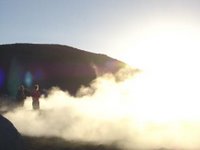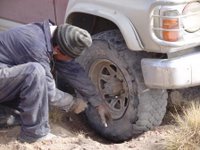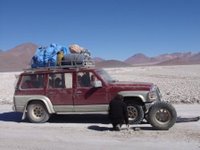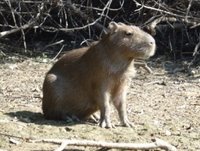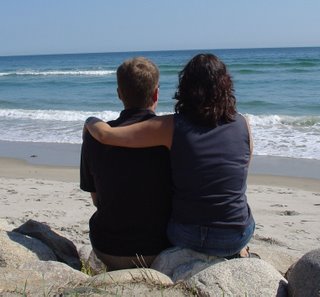Bolivia
 On the 25.5.06 very early we crossed the border into another world, from Argentina to Bolivia. It is the poorest country in Latin America. Almost 80% is living under poverty level. Whithin our first busride we could see that Bolivia is diffrent than Argentina and Chile.
On the 25.5.06 very early we crossed the border into another world, from Argentina to Bolivia. It is the poorest country in Latin America. Almost 80% is living under poverty level. Whithin our first busride we could see that Bolivia is diffrent than Argentina and Chile.
 Our first stop was in Tupiza whit 25'000 inhabitants at 2950 meter above sea level (9850 feet above sea level). This is the right place to get used to the altitude of the altiplano. We booked the "bolivian"-Triathlon for the next day. First we biked 12 km through a colorful valley. Some side-valleys we explored by jeep though. We enjoyed some short hikes before we got a typical lunch. Afterwards we went for a 2 hours horseback riding tour. Even though Peter was very excited with the fast galopp. We explored the Quebrada Seca and the Valle de los Machos (why it is called like that you can see on the picture below).
Our first stop was in Tupiza whit 25'000 inhabitants at 2950 meter above sea level (9850 feet above sea level). This is the right place to get used to the altitude of the altiplano. We booked the "bolivian"-Triathlon for the next day. First we biked 12 km through a colorful valley. Some side-valleys we explored by jeep though. We enjoyed some short hikes before we got a typical lunch. Afterwards we went for a 2 hours horseback riding tour. Even though Peter was very excited with the fast galopp. We explored the Quebrada Seca and the Valle de los Machos (why it is called like that you can see on the picture below).
After 2 hours horse back riding we were happy to get of the horses. Our butts hurted enough. With the jeep we climbed to 3500 meter above sea level (11,600 feet) from where we had a spectactular view. The downhil by bike down to Tupiza was a lot of fun.
The next day we went for the 4 day tour to the SALAR DE UYUNI, one of the highlights in Bolivia. When we boarded a Nissan, Peter already had a bad feeling and was thinking that a Toyota would have been better. With 6 passangers, driver and cook (the drivers wife and the 3 year old daugther) and all this luggage, the jeep was more than full. The tour was rough for our butts. At the beginning of the tour we suffered under altitude sickness, however the coca tee helped a lot.
 The first day was going through waste land where a lot of lamas grazed. Life seems to be very hard at this altitude. Our accomodations where very basic but clean. In the night it wasn't as cold as expected. However in the morning the windows were covered with ice. In Aquas Caliente we enjoyed a bath in the hotsprings (86F) surrounded by impressive landscape on 4,000 meter above sea level (13,500 feet). The colors of the Laguna Verde were amazing. Also the Laguna Colorado with its flamingos was impressive as well. The flamingos are sleeping on one leg. The reason for that is, so they are able to crash the ice with their other leg in the morning. We also saw other lakes, geysires and volcans.
The first day was going through waste land where a lot of lamas grazed. Life seems to be very hard at this altitude. Our accomodations where very basic but clean. In the night it wasn't as cold as expected. However in the morning the windows were covered with ice. In Aquas Caliente we enjoyed a bath in the hotsprings (86F) surrounded by impressive landscape on 4,000 meter above sea level (13,500 feet). The colors of the Laguna Verde were amazing. Also the Laguna Colorado with its flamingos was impressive as well. The flamingos are sleeping on one leg. The reason for that is, so they are able to crash the ice with their other leg in the morning. We also saw other lakes, geysires and volcans.
By the way, Peter´s concerns about the Nissan where right. We had 4 break downs with the car: 1 flat tire, 2 wheels torned to pieces and a problem with the suspension.
Before dawn we headed for the highlight of the tour, The Salar de Uyuni. Salar de Uyuni is with its 4,085 square miles (10,582 square km) the world's largest salt flat at a lofty 3,653 meter above sea level (12,200 feet).
 The salt lake is at one part up to 30 meters (90 feet) thick. Also buses and trucks can drive on it. The salt lake itself is huge. The Salar the Uyuni is estimated to contain 10 billion salt of which is less than 25000 tones is exctracted annualy.
The salt lake is at one part up to 30 meters (90 feet) thick. Also buses and trucks can drive on it. The salt lake itself is huge. The Salar the Uyuni is estimated to contain 10 billion salt of which is less than 25000 tones is exctracted annualy.
The city Uyuni did not attract us, therefore we chartered (20 persons) a bus to Potosi. It is at an altitude of 4,070 meters (13,500 feet) and has about 115,000 inhabitants. It is claimed to be the highest city in the world. Millions of laborers were conscripted to work in the mines - both indigenous people and imported African slaves. Conditions were (and remain) appalling, with as many as eight million workers dying from diseases, accidents or contact with toxic chemicals during the three centruries of colonial rule.
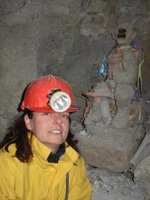 Our visit to the mines was demanding, shocking and memorable. Working practices are medieval, safety provisions nearly nonexistent and most shafts are unventilated. Miners, exposed to myriad noxious chemicals, normally die of silicosis pneumonia within 10 years of entering the mines.
Our visit to the mines was demanding, shocking and memorable. Working practices are medieval, safety provisions nearly nonexistent and most shafts are unventilated. Miners, exposed to myriad noxious chemicals, normally die of silicosis pneumonia within 10 years of entering the mines.
 La Paz lies at 3.600 meter above sea level (12,000 feet) in a 400 meter (1,350 feet) deep canyon. As higher as people live as lover is the social status. Very nice is the church San Francisco which was built in 1549. Everywhere are markets on the streets. But one market is especialy nice, the market for witches. Unfortunately somtime it was smelling bad. Some people do their business on the street, which stinks. The city is very bustling. We stayed longer than expected. The reason for that was the "bolivian" sickness. Stomach problems are every travellers pain.
La Paz lies at 3.600 meter above sea level (12,000 feet) in a 400 meter (1,350 feet) deep canyon. As higher as people live as lover is the social status. Very nice is the church San Francisco which was built in 1549. Everywhere are markets on the streets. But one market is especialy nice, the market for witches. Unfortunately somtime it was smelling bad. Some people do their business on the street, which stinks. The city is very bustling. We stayed longer than expected. The reason for that was the "bolivian" sickness. Stomach problems are every travellers pain.
We were glad to leave the city for Rurrenabaque (Bolivian Amazonas). We did a 3 days tour to the pampas. The animal diversity was awesome. We saw a lot of aligators and turtles lying on our way on the river by boat. We also could observe kaimanes, different birds and even dolphines. Unfortunately there were many moskitos as well. In the evening we listen to all kinds of noises in the jungle. The next day we were looking for anakondas and were lucky to spot one. Only 2,5 meter big (or small?).
Because of 6 hours delay with the plane we had to spend another night in La Paz. In Copacabana we arrived at the following day. Copacabana lies at the Titicacalake. Lake Titicaca is the highest commercially navigable lake in the world at 3,812 meter above sea level (12,536 feet). It is also South America's largest freshwater lake, with a surface area of approximately 8372 square kilometers.
Even at this altitude we could enjoy the sun in t-shirts. There are many little and bigger islands which were affected by the Incas. We did a visit to the Isla del Sol (Island of the sun and Isla de la Luna (Island of the moon). The legend says this is the birth place of the inca culture.
Now we are heading further to Peru. There we are going to meet with our friends Line & Patrice from Montreal, Canada. With them we are going to travell for 3 weeks in Peru.


